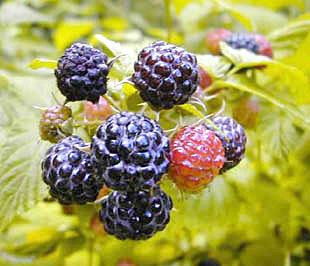I’m digging into the topic of berry management.
Here in our Michigan yard we have tons of wild black raspberries, often called “blackcaps.” Our neighbors have wild blackberries. Not blackcaps! Very different!
The blackcaps leave a little “hat” behind after you pick them and the picked berry is hollow. The purplish canes have mild, bristly thorns.
The other berries when picked come away with the hat and are solid and have a stem sticking out of them. Their canes are wickedly thorny. But we don’t have them and so we don’t worry about them.
Now, in our garden we also have wonderful everbearing red raspberries—like the wild ones, these are robust, easy to care for, produce a lot, no pests go after them…and they taste great! That’s the way I like to garden!
I love the wild berries but I prefer the everbearing reds. They have a pure, delicate raspberry flavor and aroma. The wilds are seedy. But they’re both super.
So, actually, I’m trying to figure out how to take care of both crops.
Another thing is that these berries SPREAD. So far that’s OK. The wild ones get into the grass part of the yard, so I just pull those out. I let them flourish in the margins.
With our tame ones, I’m letting them add a row to our garden every year. In the spring I dig up last year’s new sprouts and replant them into a new row. We’ll soon have the kids start taking care of them and sell berries in the subdivision behind us. At some point I’ll put a limit on the rows of berries. Like when the kids start earning too much money. : )
OK, I’ve been googling a lot and reading Martha’s “Master Gardener” book. Here are a couple good sites:
www.ehow.com/how_16245_prune-raspberries.html
I think I have a plan figured out!
For our everbearings there are several options, but after looking them over, I’ll go the simplest route and prune them to the ground every spring. The gungho gardeners seem to do it this way, so I’ll copy them. This results in a huge fall crop. Everbearings naturally have 2 crops—a tiny one (for us) in the spring and a bigger fall crop. With this simple pruning method you lose your spring crop (no big loss) but get an even-bigger fall crop. Your only worry is the frost. Our berries tend to beat the frost…just barely…I do usually lose a few that way…but we’re OK. I think…
For the wild berries I’m still a bit lost… I think that you prune them the same as tame ones (non-everbearing). I could just leave them alone, but I’ve heard that you can really boost them with a little care, so I’ll give it a whirl.
The first thing for all types of berries is that dead canes are removed. (The only time you don’t cut out an entire cane that fruited is if you’re going for a double everbearing harvest—but that’s not us.)
With our wild berries a new cane grows every year but doesn’t bear fruit until the second year. So, based on my studies, I’ll cut the new bright green canes back to 2-4 feet high in mid-summer to promote laterals, which is where the fruit happens. In spring of the 2nd year the canes will be purple—and I’ll cut all laterals off at 12″.
For the garden, I’ll thin and transplant and clear out deads, then I’ll cut ’em all down! (Maybe I’ll leave the top foot of the transplants, just to go easier on them. ?)
Sounds like a plan! –A double-whammy plan!
[Update 7/14: it’s midsummer and I note that I got crazy on the purple 2nd year canes and tipped them—these HAVE MOSTLY DIED or gotten wrinkly/withered and aren’t bearing hardly any fruit. Doh! So no more cutting tips off of purple canes—who knows, maybe I should just leave the laterals alone as well. I cut back the new green 1st year canes a month ago and they’re doing great—4 or more tips come up out of each tipped-off end so maybe this is the proliferation the books talk about. As regards my mow-down job on the everbearings in my garden: they’re going great-guns—we’ll see what they yield come late summer.]


